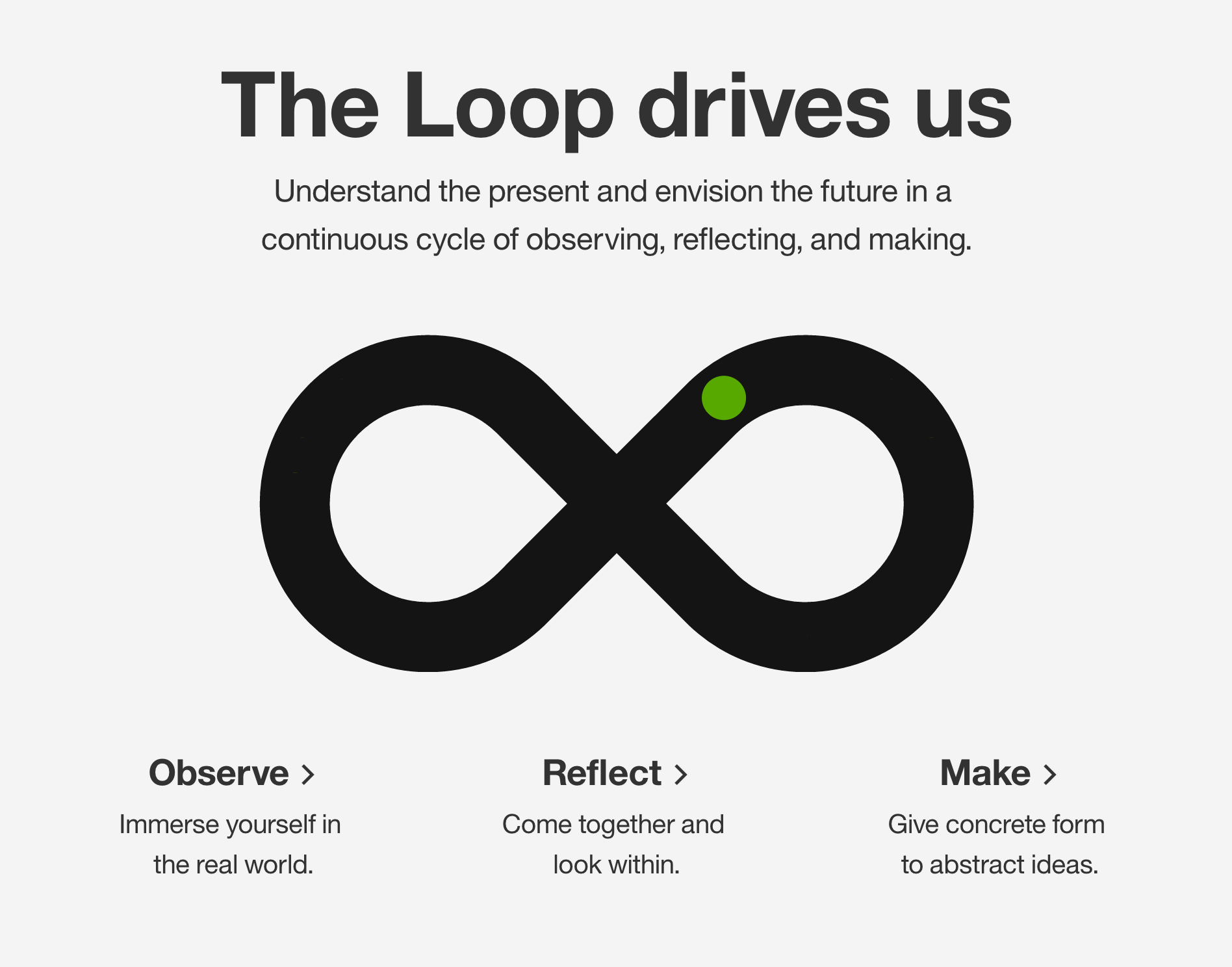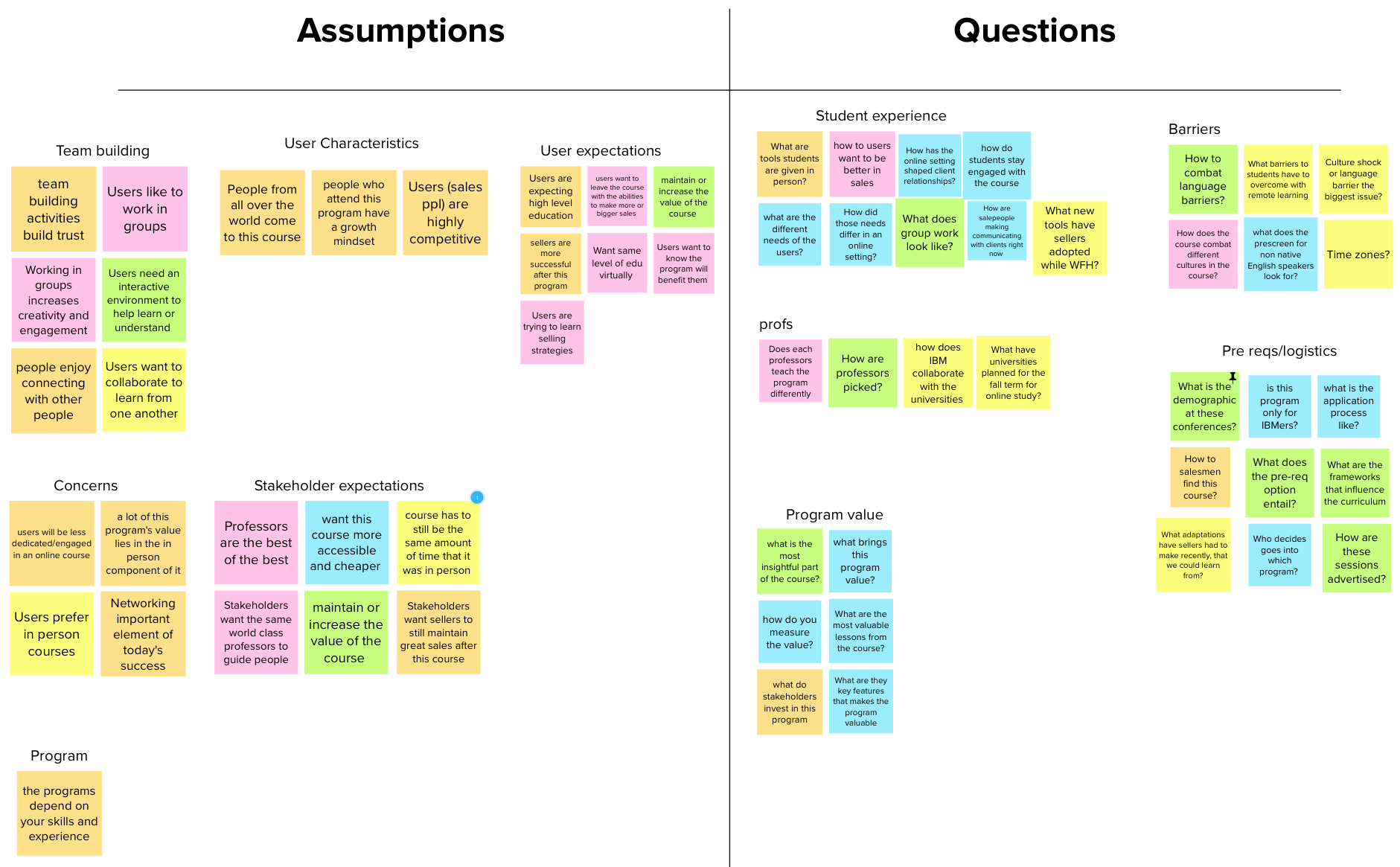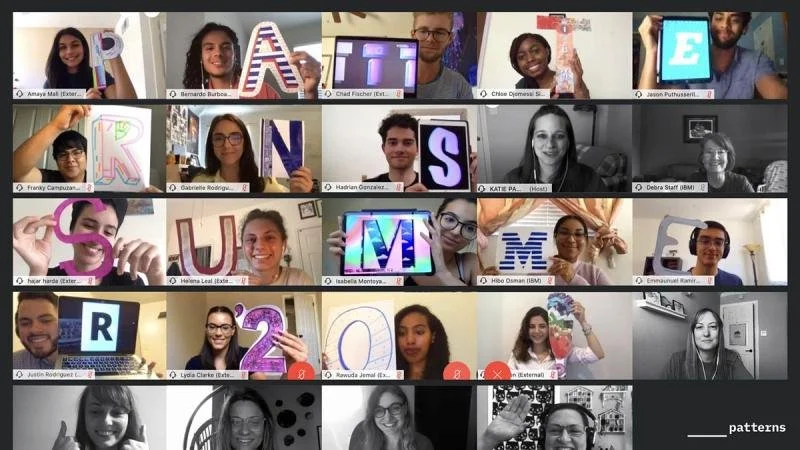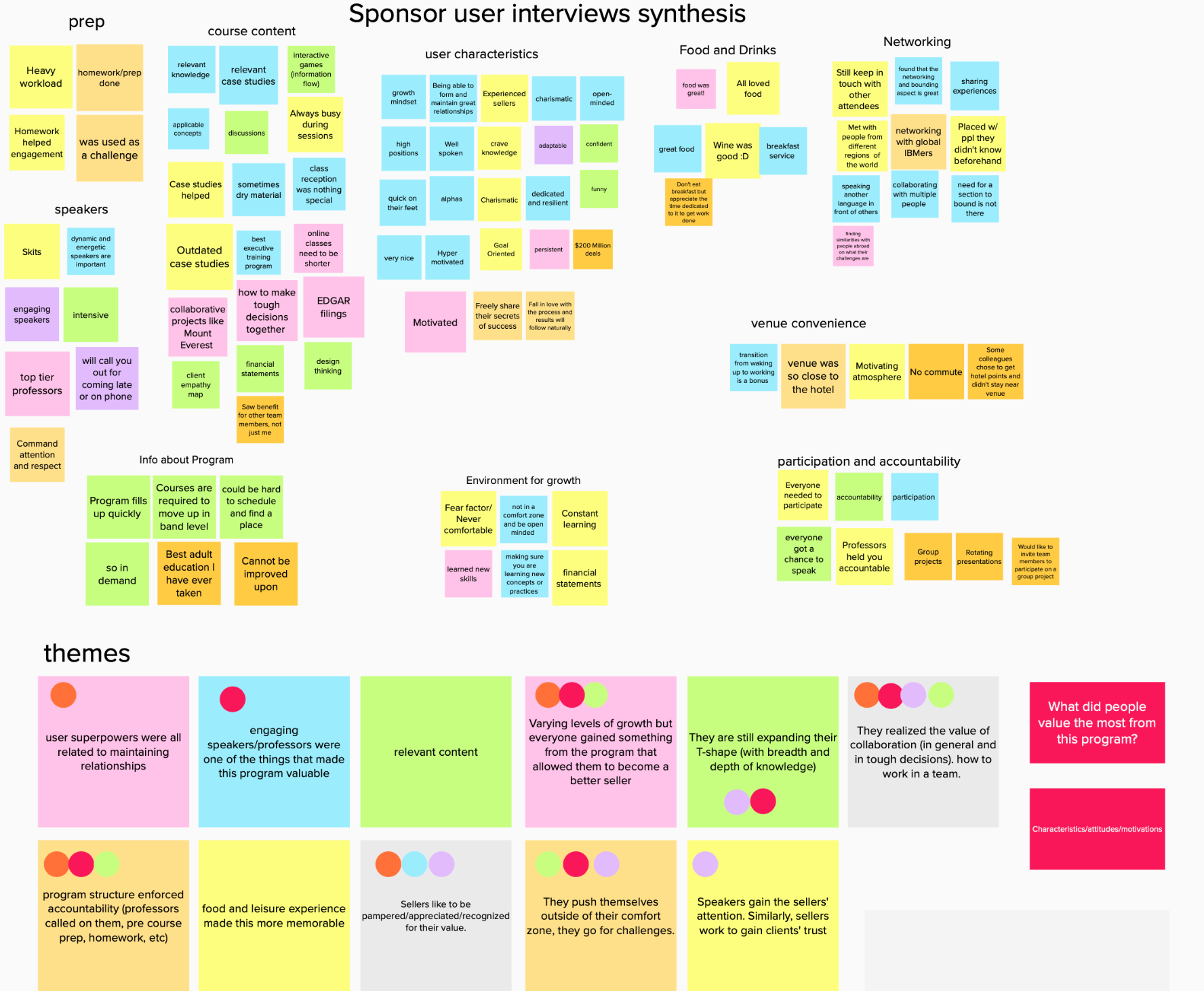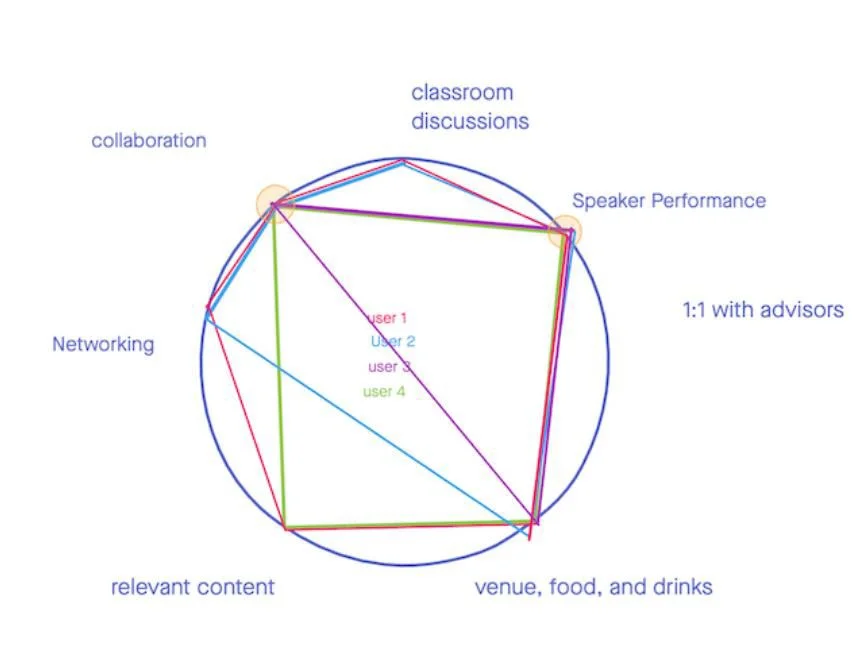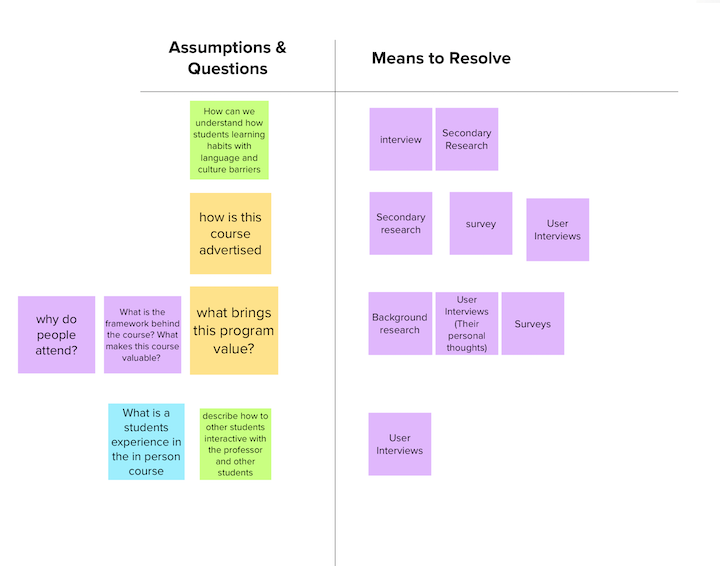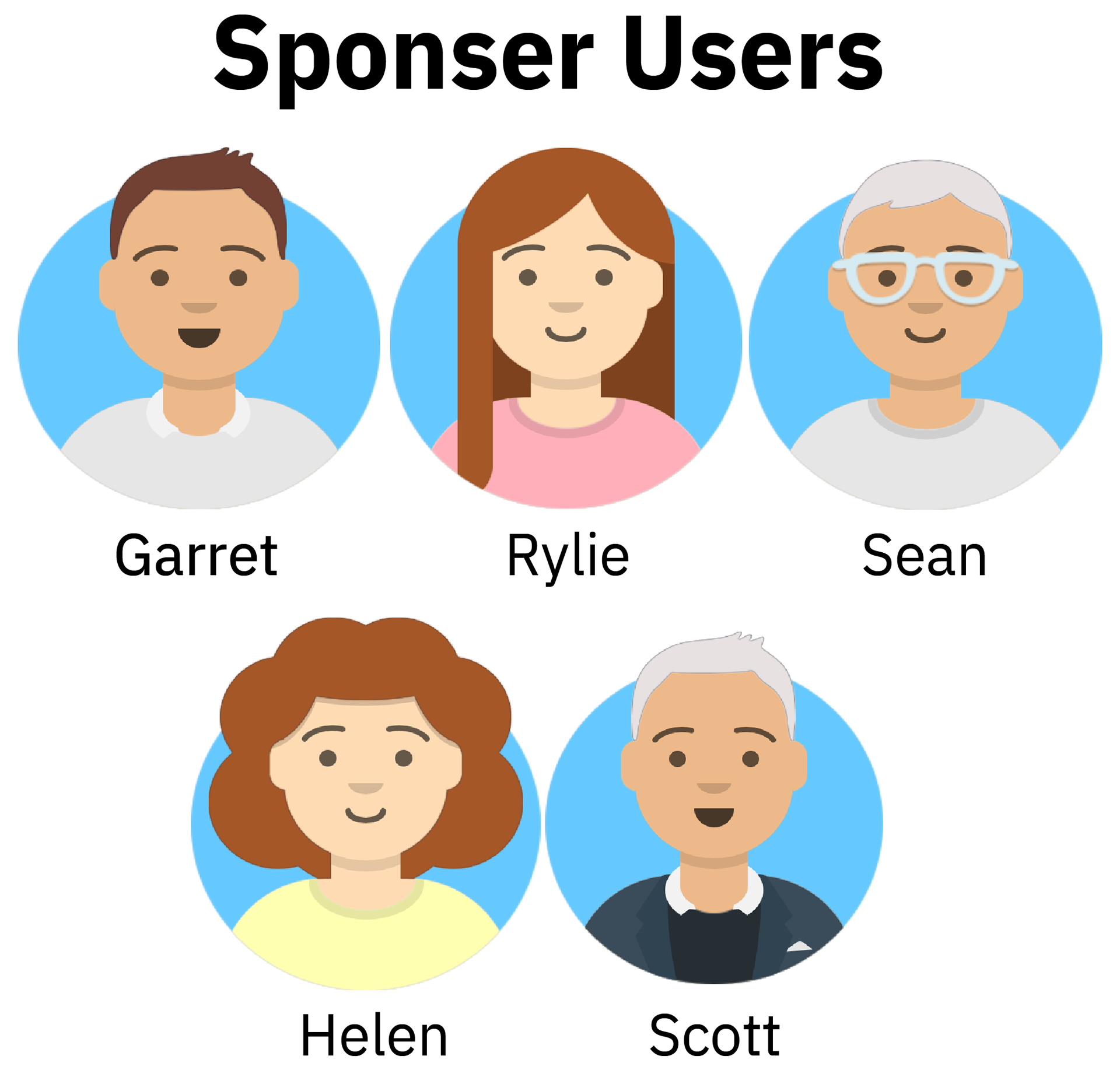“Single best executive training program I have ever attended!”
Reimagining a Training Program as a High-engagement, Cost-Efficient Online Journey @ IBM
🚨 How might we offer client relationship education to our sellers in a way that is higher quality, more cost-effective, and doesn't require them to leave their homes?
Team
Amaya Mali, Gabriel Rodriguez, and Justin Rodriguez
Timeline
8 weeks, June 2020 - July 2020
Role
UX Researcher: spearheading project research, facilitating interviews, and presenting to stakeholders.
Methods
Questions & assumptions, generative user interviews, secondary research on self-efficacy, persona creation, empathy map, user journey map
Deliverables
Service design prototype, user journey map, user experience strategy recommendations
Process overview
During this internship, we were taught and trained in IBM’s Enterprise Design Thinking framework. The framework consisted of three aspects: The Principles, The Loop*, and The Keys.
* For the purpose of this overview, I will only discuss The Loop. For a more detailed overview read this guide.Main stages of The Loop: "Observe, Reflect, and Make"
Observe
Observe users in their world, empathize with their experience, understand their context, uncover hidden needs, and hear their honest feedback. This part of the process is about seeking new opportunities to improve the project's outcomes.
Reflect
When observing and collecting data, it is easy to get overwhelmed and lose sight of the goal. Regrouping and regularly reflecting as a team, aligns your intentions and keeps you focused.
Make
Regardless of the design artifact, making encourages you to explore possibilities, communicate ideas, prototype concepts, and drive outcomes. We were encouraged to make a mess, fail fast, and fail often; the earlier you fail, the earlier you learn.
Background: More about IBM’S Patterns Internship & Incubator Project
Patterns is an 8-week design education internship at IBM. The program provides UX, Visual, Research, and Content design interns with the opportunity to develop collaboration skills in a high-pressure environment by designing solutions for actual IBM teams.
During the program, we tackled complex business problems by applying principles of ‘Enterprise Design Thinking’ in response to a range of incubator projects. These projects served as a means to ‘incubate’ new ideas and solutions.
My team addressed a problem brought about by COVID-19: How might we offer world-class education to sellers that does not require them to leave home? We partnered with the IBM’s Global Sales Department to translate three in-person training programs to online, for executive IBM sellers.
Observe: Understanding the context - Affinity mapping
Before interviewing our users, we reviewed SAIL's current program's curriculum, met with our stakeholders (sales department), developed our questions and assumptions chart that influenced the questions & methods in the research plan that I drafted for the team.
This exercise helped the team gain focus, clarity, and alignment on research goals and questions. It became clear that we have to:
1. Understand the value of SAIL's training program: why is this program valuable? what makes it valuable? how does it impact IBM sellers' professional development and client relationship?
2. Understand our users' behaviors and characteristics: what are IBM sellers like? do they have any common characteristics? what are their attitudes and beliefs around remote learning? (this was in May 2020)
Observe: Understanding our users & program - R1. Generative interviews
Because we aimed to understand why this program was so special, our users were executive IBM sellers who had previously attended the SAIL's program. Five executive IBM sellers volunteered to be interviewed by our team.
Using my research plan, we took turns asking open-ended interview questions. The interview vaguely focusing on the following:
[General and icebreaker questions]: Introductions, nature of work, and characteristics
[More about the program]: Understanding the program's value and highlights (round 1), our users' pain points and lowlights (round 2)
[More about user’s attitudes and behavior]: Understanding user’s motivations for attending and completing the program
“There is no comfort zone”
Observe: Understanding behavior change and motivations - Secondary research
After speaking to our stakeholders, we came to the understanding that the reason this program is so popular is because it instigates behavior change. Meaning, the same way designers are user centric, sellers leave this program with a client centric mindset.
Behavior change is a huge part of this program, so I took it upon myself to dig deeper and find out how to influence it, even virtually.
Fogg's Behavior Model
Motivation, ability, and trigger are all necessary conditions for behavior change. This theory provided significant insight on how we can influence organizational behavior change for our sellers, when they're back.
Each aspect of the model was integrated into our design. For example,
- Motivation: We motivated our sellers by giving out recommendations to the top participants. Additionally, since we were also attending a virtual program, we recognized how hard it is to maintain focus and motivation online, this inspired me to look into self-efficacy theory of motivation.
- Trigger: We planned for a two week follow-up meeting where the participants would get to reconnect and reflect on how they've applied what they learnt. The two week follow-up meeting will act as a trigger and reminder for all those who attended this program.
- Ability: Most importantly, sellers need to feel like they are capable of making that organizational change, which also inspired me to look into self-efficacy theory of motivation, discussed below.
Self-Efficacy Theory of Motivation
Now that we had all aspects of behavior pinned down, I researched more on building seller motivation since this can be exceptionally difficult online.
This Self-Efficacy Theory of Motivation takes into account multiple influences for self-efficacy and behavior change. Some aspects of this model were integrated into our design, for example:
- Social Persuasion: This entails receiving positive and encouraging feedback, which professors give the participants through words of encouragements and/or glowing recommendations to their bosses.
- Experience: This entails giving sellers the opportunity to practice and apply what they've learned. This is integrated through groupwork, live discussions, and case studies. We wanted our program to be more than an online lecture.
Eventually, here is what we landed on…
a. Help Sellers Help IBM:
An experienced IBM seller can take a new relationship with a client and turn it into a trusted partnership to support revenue growth for the long term future in less than a week.
b. Get The Recognition You Deserve:
An experienced IBM seller can participate in an immersive course while building internal and external eminence*
* Getting recognition for your work ethic through recommendations, badges, other rewards (to your manager) and getting sent gift baskets for your clientsc. Influence Behavior Change:
Competitive sellers are provided with education and practice that increases their self-efficacy which increases the likelihood of behavior change* therefore leading to a widespread client-oriented mindset shift at IBM
* Learning how to apply client empathy in business settings and in client interactionsMake: Mapping the current experience - As-is scenario mapping
The map walks us through the story of Billie, an IBM seller, who was nominated by her manager to attend the SAIL program in Boston.
She arrives at the hotel and is impressed by the quality of the experience. During lectures, she is engaged, she participates in discussions. At the end of the program, Billie travels back with her new credential, ready to create organizational change with her team.
Based on our user interviews and secondary research, we created this "as-is scenario" map to consolidate what we know so far about the user experience. This helped us visualize the flow of the experience as well as determine significant pain points.
Centralized Hub: sellers should find all the needed case studies and documents in one place
Edutainment: gamify aspect of the program and make it competitive to keep sellers engaged. Make them partner up or get in teams
Make: Mapping the future experience - To-be scenario mapping
Our final deliverable to our stakeholders was a journey map, detailing a comprehensive pre, during, and post training program itinerary.
1. Pre-program:
Enrollment form: Sellers would fill out an enrollment form answering questions about their housing situation (who they're living with, etc). We want to empathize with the seller's living situation and even send their loved ones swag and goodie bags!
Gift baskets: Sellers' clients would receive an IBM gift basket informing them that their seller would be unavailable and giving them someone else to contact. This would ease seller-client separation anxiety by helping the seller focus on the program work
-> Core principle: Easing Client Separation AnxietyAccess to all program materials: Sellers would get access to all case studies 2 weeks beforehand, giving them enough time to prepare
-> Core principle: Centralized hub2. During program:
Instead of having a 5 day program, we chose to condense the days into 3, from 9 AM to 3 PM. This is because virtual learning can be less engaging for that long.
We constructed a flowchart for all three days (like the one below) displaying a daily itinerary. Daily activities include: icebreakers, teamwork activities, discussions, office hours, and independent work time. Sellers who participate and are engaged during class would get glowing recommendations to their managers
-> Core principle: Accountability & Edutainment3. Post program:
Lastly, sellers would check-in with their cohort 2 weeks after they finish the program to discuss how they've applied what they've learned in their day-to-day job. Not only is this one of our core principles, but it is also the "trigger" aspect in Fogg's behavior model.
Takeaways & Challenges:
My IBM internship was one of the most valuable learning experiences so far. Even though it was remote, I was still able to connect with my teammates, interview real users, network with IBMers, learn and apply Enterprise Design Thinking, design for behavior change, and improve my presentation and communication skills, especially when presenting to non-designers.
Working on transforming an in-person training program into an online training program proved to be challenging, we were interns completing an online program and designing for an online program, we called it 'meta-design', so the pain points and concerns of our sponsor users hit close to home.
We quickly realized that the stigma behind remote learning wasn't going anywhere. Our sponsor users were understandably skeptical of what it meant to attend an "online" training program. We tried our best to design a delightful experience by integrating aspects of Fogg's Behavior Model and Self-Efficacy Theory of Motivation. Luckily, our program lead, Katie Parsons, was willing to talk us through her process of designing IBM Patterns, the program we were attending. We thought our program did a good job at keeping us engaged, focused, and motivated.
A huge takeaway was the value of storytelling in design. Whether it's presenting to our sponsor users, stakeholders, or general audience, storytelling the pain points and motivations of our persona was critical in inciting empathy for our users. Additionally, storytelling went beyond the persona, it was essential for pitching our ideas to our stakeholder and keeping them engaged.
I pushed myself outside of my comfort zone by occasionally presenting in our weekly playbacks and in our final playback, check it here! (timestamp 1:00)
Make: Visualizing key insights - Spider diagram
Repetitive themes from our affinity map emerged. It led me to drafting this a spider diagram that aimed to visualize the connection between users and those key themes. The diagram helped us prioritize MVP features (to include in our remote training program). The more users valued it, the higher priority it would be.
Collaboration and speaker performance/quality seemed to what our users valued the most.
Make: Understanding our users - Meet Billie!
She is a passionate, challenge-driven, and highly competitive seller. She is good at empathizing with clients and building deep connections with them. Billie is the embodiment of a growth mindset as she always reaches out to other sellers to constantly learn from what they're doing.
Although she has a reputation as a passionate, loyal, and empathetic seller to her clients, her co-workers don't feel inspired by her. She decides she wants to develop her skills further to strengthen her relationships with her clients and co-workers so that she can become a better seller and improve her commissions*. She wants to show her boss that she deserves a promotion and will be a competent leader for her team.
Her manager nominates her for the SAIL training program that will help her become an even better seller and better leader for her team.
* Fun fact: IBM sellers have to earn 45% of their salary back in commissionsReflect: Synthesizing our findings - Drafting IBM Hills
Hills are statements of intent made to align the team with the goal but never how to get there.
Hills are compromised of who (end user), what (the objective), and the wow (how to differentiate and measure success).
Drafting these hills was one of our struggles as a team, especially when it came to measuring the success of our program. We brainstormed separately, brainstormed as a team, presented to senior designers, got feedback, reached out to our mentors, presented to our stakeholders, and got feedback. Weeks passed by and our Mural board kept growing. Here's what our brainstorming and iterating phase looked like:
Reflect: Defining MVP Requirements - Core guiding principles
Creating a prototype for an experience was also a challenge for our team. We decided to present the prototype as an itinerary wireframe on Invision.
Our usability testing sessions consisted of us walking our sponsor users through the wireframe and taking their feedback on what they think is working and what isn't.
After two rounds of testing, we identified five core guiding principles that would allow our solution to be recreated and scaled, with time.
All five of these core principles were integrated into our design and are highlighted in orange in "To-be Scenario Mapping."
Applicable learning: sellers should be able to learn applicable and relevant content
Reflect: Uncovering user pain points - R2. Generative interviews
We ran a second round of interviews aiming to understand our user pain points and lowlights, during the program. This informed us of what we should avoid or be wary of.
We affinity mapped, again. Our interview synthesis uncovered the following pain points:
Time commitment: Program was held in Boston for 5 working days. It was a long time to be away from the office, clients, and their family. This contributed to "Client Separation Anxiety", a term I coined.
Intense & tough to balance: It was tough to balance between the program work (reading case studies and doing assignments) and client work.
Expensive: Program's tuition, accommodation, & travel comes out of the department’s budget. Unfortunately not all departments can afford that dip in the budget.
High popularity/low availability: This program is popular among IBM sellers but not very accessible to many, due to low availability.
Easing Client Separation Anxiety: ease the anxiety of being away from client, by sending gift basket with alternative contact information
Accountability: sellers to be engaged and held accountable, even remotely, and professors should enforce that
Reflect: Understanding our users - Empathy map
After synthesizing our user interviews, identifying program value, and pain points, it was time to construct an empathy map. The empathy map helped us consolidate our observations on seller behavior, attitudes, and characteristics to inform our persona: Billie.
*To protect the privacy of our users, their names have been altered. Reflect: Synthesizing user interviews - Affinity mapping & key insights
Following our user interviews, it was time to reflect on what we've learned so far. We affinity mapped, as a team. Slowly, key insights like the program’s value began to show. This guided our MVP feature prioritization. Main findings included:
Users found the program to be high in quality, engaging, and challenging
There is a stigma revolving around a remote training program; people perceive it as less engaging
Breaking this stigma made our task more challenging
These are actual user quotes
:)
These are actual user quotes :)
“It doesn’t feel like class, it feels like enrichment”

